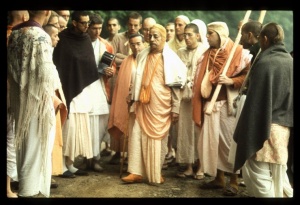CC Madhya 3.41

A.C. Bhaktivedanta Swami Prabhupada
TEXT 41
- prathame pāka kariyāchena ācāryāṇī
- viṣṇu-samarpaṇa kaila ācārya āpani
SYNONYMS
prathame—first; pāka—cooking; kariyāchena—performed; ācāryāṇī—the wife of Advaita Ācārya; viṣṇu-samarpaṇa—offering to Lord Viṣṇu; kaila—did; ācārya—Advaita Ācārya; āpani—Himself.
TRANSLATION
All the eatables were first cooked by the wife of Advaita Ācārya. Then Śrīla Advaita Ācārya personally offered everything to Lord Viṣṇu.
PURPORT
This is the ideal householder’s life. The husband and wife live together, and the husband works very hard to secure paraphernalia for worshiping Lord Viṣṇu. The wife at home cooks a variety of foods for Lord Viṣṇu, and the husband offers it to the Deity. After that, ārati is performed, and the prasādam is distributed amongst family members and guests. According to the Vedic principles, there must always be a guest in a householder’s house. In my childhood I have actually seen my father receive not less than four guests every day, and in those days my father’s income was not very great. Nonetheless, there was no difficulty in offering prasādam to at least four guests every day. According to Vedic principles, a householder, before taking lunch, should go outside and shout very loudly to see if there is anyone without food. In this way he invites people to take prasādam. If someone comes, the householder offers him prasādam, and if there is not much left, he should offer his own portion to the guest. If no one responds to his call, the householder can accept his own lunch. Thus the householder’s life is also a kind of austerity. Because of this, the householder’s life is called the gṛhastha-āśrama. Although a person may live with his wife and children happily in Kṛṣṇa consciousness, he also observes the regulative principles followed in any temple. If there is no Kṛṣṇa consciousness, the householder’s abode is called a gṛha-medhī’s house. Householders in Kṛṣṇa consciousness are actually gṛhasthas—that is, those living in the āśrama with their families and children. Śrī Advaita Prabhu was an ideal gṛhastha, and His house was the ideal gṛhastha-āśrama.